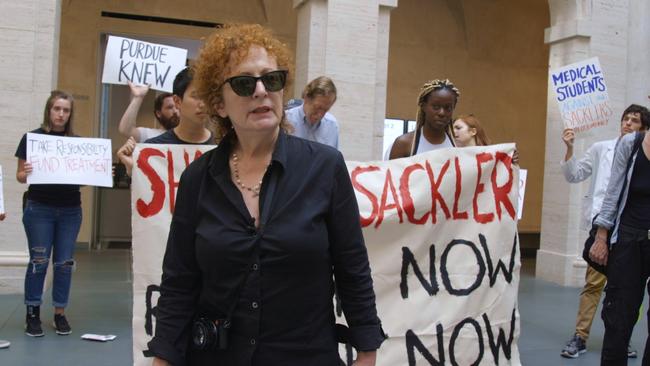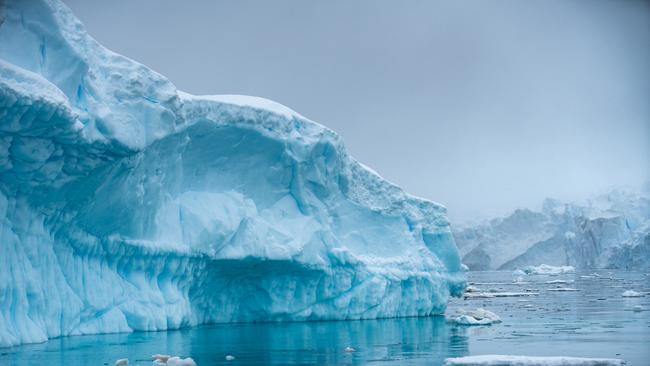Nan Goldin fights opioid industry in All the Beauty and the Bloodshed
All the Beauty and the Bloodshed is a documentary about an American bisexual, chain-smoking photographer - and activist who takes on big pharma.

All the Beauty and the Bloodshed (R18+)
In cinemas
★★★★½
The surprise winner of the Golden Lion at Venice last year, All the Beauty and the Bloodshed, is an immensely powerful documentary that works on a number of levels.
To start with the film is a portrait of Nan Goldin, an American bisexual, chain-smoking artist/photographer. By way of background Goldin describes her stifling suburban childhood and her deep affection for Barbara, her older sister, who was institutionalised and later committed suicide.
Goldin herself became a bohemian, living with the so-called outcasts of society in Boston and later in New York, all the time taking colour photos of her friends and lovers. She lived through the AIDS epidemic during which several of her friends died.
A vital part of her story, which becomes the main theme of the film, covers Goldin’s radicalism and the organisation, P.A.I.N. (Prescription Addiction Intervention Now), that she started to fight the Sackler family, whose drug company, Purdue Pharma, produced first Valium and then OxyContin, a drug that was marketed via doctors without revealing that it was addictive and potentially lethal.
An earlier documentary about the Opiod scourge, Alex Gibney’s The Crime of the Century (2021), also explored the ways in which Purdue Pharma allegedly deliberately set out to make people addicted to opioids, an addiction that has caused the estimated deaths of 500,000 people in the US alone.
“You can’t trust big pharma” has been a mantra of the anti-vaxxers, and perhaps you could argue that the history of Purdue and the Sacklers offers a degree of support to the conspiracy theorists, though this film doesn’t take us down that rabbit hole.
And there’s a complicating factor: the Sacklers made huge profits out of the drugs they sold but they have been extremely generous philanthropists, donating millions of dollars to art galleries, museums and universities in several countries. New York’s Metropolitan Museum of Art had a Sackler Wing, and the Louvre, the Tate in London and the Guggenheim have all received badly needed donations of Sackler money. P.A.I.N. set out to call attention to this and to stop it. The organisation also pledged to get Purdue to pay recompense to the victims and families of victims who died as a result of opiod addiction.
Unsurprisingly, the company declared bankruptcy before any resolution can be arranged. Demonstrations take place at famous galleries (copies of the opiod prescriptions are showered from the upper floors of the Guggenheim) and these form a major part of the P.A.I.N. campaign, all of which raises some difficult questions: the Sacklers have made money from drugs that have destroyed lives – can this be in any way condoned because they’ve donated so much money to cash-starved arts organisations? I would hope not.
There’s a level of comparison here with the Australian debate over poker machines which have also undoubtedly destroyed lives while, allegedly, keeping clubs and pubs solvent.
As you can see, All the Beauty and the Bloodshed is a great discussion starter.
Director Laura Poitras explores both Goldin’s art – her photographs are outstanding – and her activism plus the ways in which the two sides of her activity are inextricably intertwined.
The result is a thought-provoking documentary and a worthy winner of the top prize in Venice.
Shackleton: The Greatest Story of Survival (PG)
In cinemas
★★★★
In 1948 the primary school I was attending organised a trip to a local cinema to see the British film Scott of the Antarctic, the compelling story of Robert Falcon Scott, played by John Mills, who, in 1911, attempted, but failed, to be the first to reach the South Pole and who perished along with his fellow explorers on the homeward journey. What a film to show impressionable pre-teens: a film about a noble failure that celebrates a very Stiff Upper Lip acceptance of a chilly death.
I mention this because, oddly enough, the new Australian documentary film, Shackleton: The Greatest Story of Survival, fails to refer to Scott or, indeed, to the Norwegian Roald Amundsen who beat Scott to the South Pole. You would have thought that these courageous pioneers deserved at least a word, but no.
Ernest Shackleton (1874-1922) was born in Ireland but raised in London. He was third officer on Scott’s first expedition (1901-1904) to Antarctica. In 1914, after Amundsen’s successful journey to the Pole in December, 1911 (and Scott’s death a month later), Shackleton organised an expedition to traverse the bleak continent from sea to sea. Much of his journey was recorded by the silent movie camera of Australian Frank Hurley whose extraordinary images are as vivid today as they were then.
The journey was plagued with difficulties; the ship, Endurance, became trapped in pack ice and was slowly crushed. Shackleton and his men found themselves stranded on the icy continent, but thanks to extraordinary courage and teamwork they all survived. Lugging lifeboats over the ice they eventually wound up on Elephant Island on an inhospitable beach hemmed in by high cliffs; from here Shackleton and five companions took off in one of the boats to row the 800 miles (1287km) to South Georgia where there was a whaling station and where help could be found. This challenging voyage in an open boat across mountainous seas was one of the expedition’s finest achievements but when they reached South Georgia Shackleton and his companions found themselves on the wrong side of the island from the station and were forced to climb over a high range of snow-capped mountains.
The Hurley footage of Shackleton’s expedition – not always presented in the correct aspect ratio – is accompanied by a more recent adventure by Tim Jarvis, an adventurer who travelled in Shackleton’s footsteps, seeing the same austere landscapes over 100 years later and remarking on the differences brought about by climate change.
The film, made by Bobbi Hansel and Caspar Mazzotti, juxtaposes the journeys of these two adventurers with skill. Entries from Shackleton’s diaries are read by Rupert Degas, and they are wonderful to hear, being either bleakly poetic (“We had reached the naked soul of men”) or bravely stoic (“It seems that the general discomfort of our situation could scarcely have been increased.”)
This film is a visual treat and a reminder of the great achievements in exploration that took place in the early 20th century. More than that, it’s a tribute to all the heroic adventurers who have risked their lives to explore the Great Unknown.



To join the conversation, please log in. Don't have an account? Register
Join the conversation, you are commenting as Logout